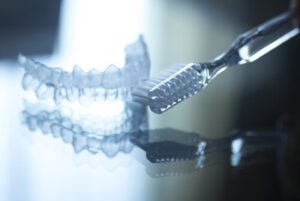Starting the journey of orthodontic treatment is an exciting step toward achieving that perfect smile you’ve always desired. For many, Invisalign clear aligners are the go-to option for a more discreet and comfortable experience. However, an often overlooked yet vital component in the Invisalign treatment process plays a crucial role in ensuring optimal results: Invisalign elastics.
You might have heard of Invisalign elastics—also known as Invisalign rubber bands—but what exactly do they do, and why are they so important? These rubber bands are essential in addressing specific bite conditions such as overbites, underbites, and crossbites. They enhance treatment efficiency and aesthetics when combined with clear aligners. Let’s dive into the world of these small but mighty bands and explore how they contribute to your orthodontic success.
What Exactly Are Invisalign Elastics, and Why Do You Need Them?

Unlike the traditional braces setup, where rubber bands are hooked onto brackets, rubber bands with Invisalign are attached to small Invisalign attachments or hooks on your aligners. Depending on the bite issues that need correction, these bands can be connected between the upper and lower teeth or on certain teeth within the same arch.
Harnessing the Power of Elastics: The Science Behind the Force
You may wonder how these tiny bands can influence your teeth’s movement. It’s all about physics—specifically, the application of additional force. Wearing elastics with Invisalign creates tension between the teeth where the bands are placed, gradually shifting them toward their desired positions. Rubber bands work similarly to braces, applying the necessary force to align teeth properly.
For instance, if you have an overbite (where the upper teeth overlap the lower teeth), your dentist might instruct you to wear rubber bands in a way that pulls the lower teeth forward and the upper teeth backward, promoting proper alignment. Conversely, in the case of an underbite, the elastics can help move the upper teeth forward and the lower teeth backward.
These elastics can also address more complex issues, such as an open bite, where the upper and lower teeth do not align correctly when the mouth is closed. The aligners can close the gap by strategically placing the elastics, ensuring a more functional and aesthetically pleasing bite.
Invisalign Elastics vs. Traditional Braces: A Modern Approach with Invisalign Aligners
In the world of orthodontics, traditional braces have long been the gold standard for correcting bite issues. They work effectively, but they’re not without their challenges. Braces are often seen as bulky, uncomfortable, and highly visible. This is where Invisalign shines, offering a modern, nearly invisible solution that fits seamlessly into your lifestyle.
However, both braces and Invisalign can incorporate rubber bands to achieve premium results. The major difference lies in the way these bands are used. With Invisalign, the elastics are more discreet, and the aligners can be removed, making it simpler to uphold good oral hygiene. Plus, the clear aligners are custom-made to fit your teeth snugly, adding extra grip when combined with the rubber bands, which ensures that your teeth move efficiently into place.
Tips for Success: How to Wear Rubber Bands with Invisalign
Wearing elastics might seem like a minor part of your Invisalign treatment, but following your dentist’s instructions carefully is crucial to achieving optimal results. Here are some tips to ensure you’re on the right track:
Consistency is Key: Wear your elastics for the prescribed number of hours each day. This is typically 20-22 hours. Remove them only when you’re eating or brushing your teeth.
Replace Regularly: Always use a fresh pair of elastics daily, as they can lose elasticity over time, reducing their effectiveness.
Proper Placement: Pay close attention to how your dentist instructs you to place the elastics. Incorrect placement can lead to unintended tooth movement.
Stay Prepared: Keep extra elastics with you at all times, just in case one snaps, or you need to replace them while you’re out and about.
Good Oral Hygiene: Since you’ll be wearing elastics most of the day, it’s important to maintain good oral hygiene. Use a toothbrush with soft bristles to clean both your aligners and teeth and floss regularly to prevent dental issues.
Addressing Common Concerns: The Comfort and Challenges of Wearing Elastics
It’s natural to have concerns about wearing Invisalign elastics, especially if you’ve never used them. Initially, you may experience discomfort as your teeth adjust to the additional pressure. However, this discomfort usually subsides after a few days.
Some patients worry about the visibility of the elastics but rest assured; they are quite discreet. The elastics are clear, just like your aligners; most people won’t notice them. If you follow your dentist’s advice and wear the elastics as directed, you’ll quickly get used to them, and they’ll become a seamless part of your Invisalign process.
The Importance of Following Your Dentist’s Instructions: Why Compliance is Crucial

Your dentist may adjust your treatment plan as you progress, and wearing elastics as prescribed will help ensure that your teeth move as expected. Skipping or improperly wearing elastics can delay your treatment process, potentially requiring additional time to achieve the desired results.
Frequently Asked Questions About Invisalign Elastics
- Can I use any type of rubber band with my Invisalign aligners?
No, you should only use the elastics provided by your dentist. These are specifically designed to work with your Invisalign treatment plan, and applying different types of rubber bands can compromise your results.
- Will wearing elastics affect my speech?
Wearing elastics might slightly affect your speech when you first start using them, but most patients adjust quickly. Any minor speech changes usually disappear within a few days as you get used to the elastics.
- Can I skip wearing my elastics if my teeth feel sore?
It’s normal to experience some soreness when you first start wearing elastics, but it’s important not to skip wearing them. The discomfort is a sign that the elastics are working to move your teeth, and it usually subsides within a few days. If the pain persists, consult your dentist for advice.
- What if I forget to wear my elastics for a day?
Missing a day of wearing your elastics can delay your treatment progress. If you forget to wear them, get back on track as soon as possible and wear them consistently according to your dentist’s instructions.
- Are there any specific foods I should avoid while using Invisalign elastics?
While you should remove your elastics before eating, it’s also important to avoid sticky or hard foods that could damage your aligners. Proper care of your aligners will help maintain the integrity of your treatment.
- Will I need to wear Invisalign elastics for the entire duration of my treatment?
The length of time you’ll need to wear elastics varies depending on your specific treatment plan. Your dentist will offer guidance depending on your progress, and you may only need to wear them during certain phases of your Invisalign treatment.
Your Final Destination: A Perfect Smile Awaits

Remember, every step of your Invisalign journey, from wearing aligners to placing elastics, brings you closer to that perfect smile. Keep up with good oral hygiene, follow your treatment plan, and trust in your dentist’s expertise. Before you know it, you’ll be flashing a more aligned bite and a confident, beautiful smile that you’ll be proud to show off.
If you’re considering Invisalign or need more information about how elastics can enhance your treatment, contact Balmoral Dental Centre at (07) 3113 9789. Our team is dedicated to supporting you throughout your journey, making sure your path to a straighter, healthier smile is both seamless and successful.
References:
Healthline. (n.d.). Invisalign rubber bands: What to know. https://www.healthline.com/health/dental-and-oral-health/invisalign-rubber-bands
Colgate. (n.d.). How to practice oral hygiene with braces. https://www.colgate.com/en-us/oral-health/kids-oral-care/how-to-practice-oral-hygiene-with-braces
Cleveland Clinic. (n.d.). Teeth braces. https://my.clevelandclinic.org/health/treatments/24601-teeth-braces

